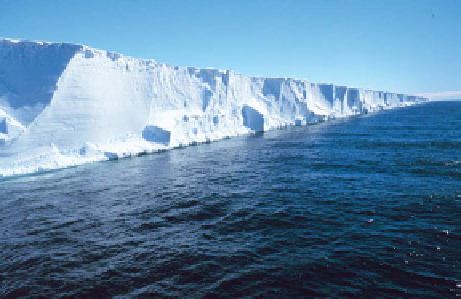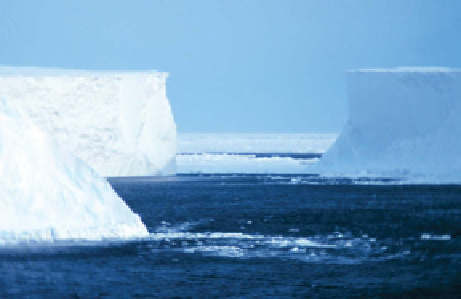Geoscience Reference
In-Depth Information
(a)
(b)
Figure 12.19.
(a) Edge of Ross Sea ice sheet, December 1996. (b) Icebergs grounded on Pennel Bank, Ross
Sea, Antarctica, January 1999. Michael Van Woert, NOAA NESDIS, ORA. available from NOAA Central Library,
www.photolib.noaa.gov/.
During the
Oligocene epoch
(33.9-23.03 m.y.a.),
temperatures continued the decline that started during
the Eocene epoch. The temperature drop triggered the
expansion of Antarctic ice cover starting 31 to 29 m.y.a.
From 26 to 15 m.y.a., during the early
Miocene epoch
(23.03-5.332 m.y.a.), temperatures temporarily stabi-
lized. From 15 to 10 m.y.a., they dropped more, increas-
ing Antarctic ice coverage and decreasing sea levels.
The cause of this temperature decrease may have been
a decrease in CO
2
(g) due to changes in ocean water
vertical mixing (Crowley and North, 1991).
From 5 to 4 m.y.a., during the early
Pliocene epoch
(5.332-2.588 m.y.a.), temperatures rebounded slightly,
reducing Antarctic ice sheet areas. Although much of
the Northern Hemisphere was warm during the early
Pliocene, seasonal
sea ice over the Arctic Ocean
and
glaciers in Alaska
began to form 5 to 6 m.y.a. and
persisted thereafter (Clark et al., 1980; Zubakov and
Borzenkova, 1988). From 2.6 to 2.4 m.y.a., a sharp
decrease in temperature caused trees to disappear in
Northern Greenland and tundra to expand in Siberia.
The
Greenland ice sheet
may have formed during
this cooling period, although evidence for its forma-
tion between 3 and 4 m.y.a. has also been suggested
(Leg 105 Shipboard Scientific Party, 1986).
present) have resulted in our present overall period
being referred to as the
Quaternary Ice Age
.Thisice
age ranks among the four longest in the Earth's history,
along with the Karoo, Sturtian-Marinoan/Varanger, and
Huronian ice ages.
Between the late Pliocene epoch and 700,000 years
ago (y.a.), during the
Pleistocene epoch
(2.588 m.y.a.-
11,700 y.a.), fluctuations in the advances and retreats
of ice sheets occurred within a period of about
40,000 years (Shackleton and Opdyke, 1976). Between
700,000 y.a. and the present, such advances and retreats
have occurred within periods of about 100,000 years.
These fluctuations can be explained as follows.
Figure 12.20 shows temperature changes during the
past 450,000 years, a period covering nearly one-fourth
of the Pleistocene epoch. It also shows carbon dioxide
and methane trends over the past 420,000 years. Data
for the table were obtained from the Vostok, Antarc-
tica, ice core. The Vostok core was obtained by drilling
through ice down to a depth of more than 3.6 km, a depth
representing 450,000 years of atmospheric history.
The Earth has gone through four glacial and inter-
glacial periods every 100,000 years over the past
450,000 years. Within these major periods are minor
oscillations. The major and minor temperature oscilla-
tions can be explained for the most part by three cycles
related to the Earth's orbit, called
Milankovitch cycles
,
which are named after Serbian astronomer
Milutin
Milankovitch
(1930, 1941). They are caused by grav-
itational attraction between the planets of the solar
system and the Earth. Milankovitch was the first to
calculate the effects of these cycles on incident solar
radiation reaching the Earth. The cycles are briefly dis-
cussed next.
12.3.2.6. From 3 Million Years Ago
to 20,000 Years Ago
The past 3 million years have been characterized by
advances and retreats of Northern Hemisphere ice
sheets. The relatively cold temperatures and the contin-
uous presence of at least one ice sheet (over the Antarc-
tic) during the
Quaternary period
(2.588 m.y.a.-



Search WWH ::

Custom Search